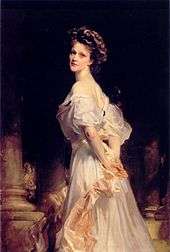Pompadour (hairstyle)
.png)

Pompadour refers to a hairstyle which is named for Madame de Pompadour (1721–1764), mistress of King Louis XV.[1] Although there are numerous variations of the style for both men, women, and children, the basic concept is hair swept upwards from the face and worn high over the forehead, and sometimes upswept around the sides and back as well.
After its initial popularity among fashionable women in the 18th century, the style was revived as part of the Gibson Girl look in the 1890s and continued to be in vogue until World War I. The style was in vogue for women once again in the 1940s. The men's version, as worn by early country and rock and roll stars such as Elvis Presley, was popular in the late 1950s and early 1960s. Variations of the pompadour style continue to be worn by men and women in the 21st century.
Women's styles
Among women, the hairstyle has become marginally popular again in the first few years of the 21st century. It can be created by backcombing or ratting at the roots of the hair on the sides of the pompadour towards the top of the head. Then the hair is combed up and over the ratted hair, off the forehead, the front up in a curl straight back, and the sides pulled back towards the center.
In Japan, the punch perm combines elements of the afro hairstyle and the traditional pompadour. This hairstyle is stereotypically worn by less reputable members of society, including the yakuza, bōsōzoku, and chinpira (street thugs).
In the psychobilly subculture, the pompadour is slightly modified to form the quiff. The quiff is a hairstyle worn by Psychobilly fans and musicians (Kim Nekroman frontman of Nekromantix for example). A quiff is a sort of mix between a mohawk hairstyle and the pompadour, where the hair along the side of the head is shaved and the middle is not spiked but slicked back and stood up like a pompadour.
-

Lady Astor wearing a pompadour style in a famous portrait by John Singer Sargent, 1909.
-

Bette Davis wearing an updated pompadour in the film Now, Voyager, 1942.
-

Actress and World War II pin-up girl Betty Grable wearing another variant of the pompadour style, 1943.
Men's styles

In recent years the pompadour hair style has been adopted by those enamoured with vintage culture of the late 1950s and early 1960s, which includes antique cars, hot rods, muscle cars, American folk music, greasers, rockabilly bands, and Elvis Presley, Afghanistan's Ahmad Zahir as well as actors such as James Dean and Desi Arnaz.
There are Latin variants of the hair style more associated with European and Argentine tango fashion trends and occasionally with late 20th century musical genres such as rockabilly and country.
This style has become popular among Italian Americans and the "goombah" or "Guido" subculture. The style is often parodied in shows like The Sopranos, which portray negatively stereotyped characters—especially Silvio Dante.
In modern Japanese popular culture, the pompadour is a stereotypical hairstyle often worn by gang members, thugs, members of the yakuza and its junior counterpart bōsōzoku, and other similar groups such as the yankii (high-school hoodlums). In Japan the style is known as the "Regent" hairstyle, and is often caricatured in various forms of entertainment media such as anime, manga, television, and music videos, often into improbable levels of length and volume.
Today, the pompadour hairstyle is worn on celebrity men and women which include Conan O'Brien, Bruno Mars, Morrissey, Macklemore, David Beckham, Logan Fife, Zac Efron, Zayn Malik, Alex Turner of Arctic Monkeys, Drake Bell, and Justin Timberlake, Leigh-Anne Pinnock, Jesy Nelson.
See also
References
- ↑ Sherrow, Victoria (2006). Encyclopedia of Hair: A Cultural History. Greenwood Publishing Group. pp. 309–310.
External links
Definition
- Merriam-Webster definition. Retrieved 25 April 2005.
Rockabilly connection
- "Lord Carrett's Pompadour Page". Retrieved 25 April 2005.
- "Pompadour". A Word A Day Archives. Retrieved 25 April 2005.
- Trebay, Guy (November 18, 2003). "Hidden for Years at Graceland, His Clothes Have Left the Building". Elvis Australia. Retrieved 25 April 2005.
Setzer connection
- Abrams, Kerry (February 8, 1999). "Setzer Swings Into Town". The Daily Beacon. Retrieved 25 April 2005.
- Burrell, Dan (November 28, 2008). "More Discussion Regarding Emergent Methodology". Whirled Views With Dan Burrell. Retrieved 30 December 2008.
- Hinke, Christina M. "Brian Setzer Puts the Swing Into the Holidays" (interview with Setzer, mentioning hair style). Associated Press, reprinted on Hoodoo Voodoo Lounge fan site. Retrieved 25 April 2005.
- Hinke, Christina M. (October 10, 2005). "Brian Setzer Rocks and Doo-wops his Way Through New Album". Associated Press. Retrieved 25 April 2005.
- Townsend Records Shop description of Brian Setzer. Retrieved 25 April 2005.
Examples of non-rockabilly male musicians with pompadours
- "Nick Cave Kinder and Gentler? Not Quite". (March 27, 2001). Reprise Records News. Retrieved 25 April 2005.
- Leiby, Richard (January 21, 2002). "Joe Henry: Too Big Too Fit". The Washington Post, pg. C1.
Tango and Latin connection
- Foley, Dylan (November 22, 1977). "Tango: Looking for Love in All the Wrong Places". Toronto Globe and Mail. Retrieved 25 April 2005.
- "Tressed to Kill". (February 9, 2005). New York Post. Retrieved 25 April 2005.